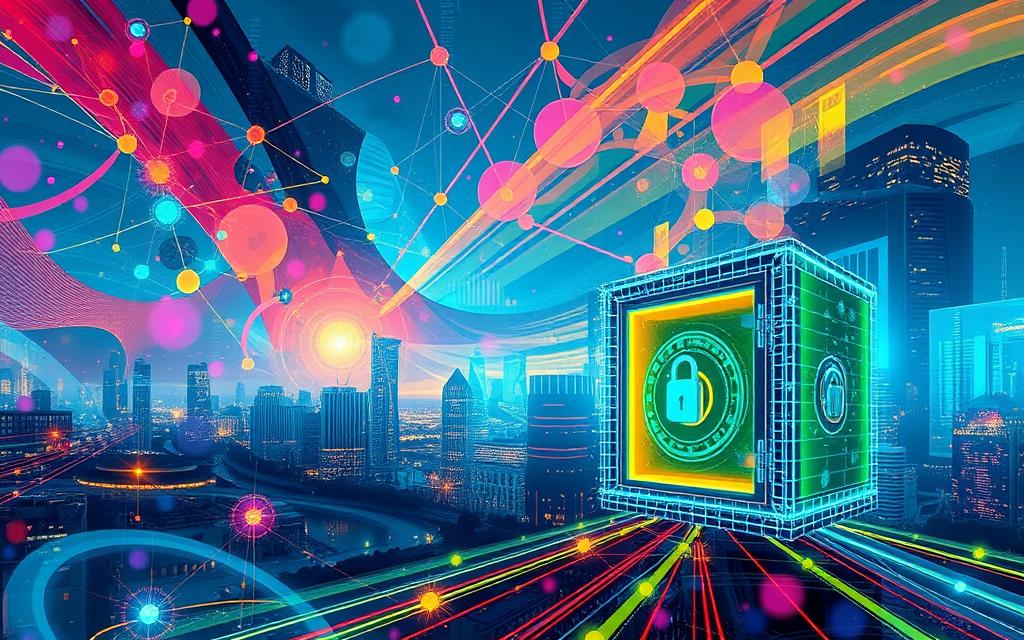Imagine a world where your digital identity is yours alone. You control your personal info, not online services. This dream is now a reality with self-sovereign identity (SSI) in Web3 identity.
Centralized identity systems have big problems. Cybercriminals make millions from formjacking attacks. Businesses spend a lot on cybersecurity to fix these issues.
DID protocols and SSI offer a secure world. Identity theft and data breaches are less common. With digital wallets and blockchain, users control their identity. This is good for businesses that value authenticity.
The Self-Sovereign Identity model is at the heart of this change. It shifts identity management to a safer place. Here, digital personas can grow without fear of misuse.
Key Takeaways
- SSI uses advanced cryptography for fraud-proof certifications and quick verification. This brings security and efficiency.
- The move to self-sovereign identity is key. It upholds ten principles for user autonomy and protection online.
- Web3 identity frameworks offer a smooth, cross-platform experience. This lets a single digital identity work on many platforms.
- By using decentralized identifiers and blockchain, Web3 identity protects personal info. This gives power back to the individual.
- The shift to Web3 is more than a tech upgrade. It’s a new way of seeing, valuing, and managing identities online. Self-sovereignty is at its core.
Understanding the Shift to Self-Sovereign Identity in Web3
The internet has changed a lot, making digital interactions more private and user-friendly. Web3 identity uses decentralized systems, unlike the old centralized ones. This change is big for keeping user data safe and under control.
Centralized vs Decentralized Identity Models
Centralized systems let one entity control all user data. This is risky because it’s easy to get hacked. On the other hand, decentralized systems use blockchain to spread data, making it safer and giving users more power.
Decentralized systems are better because they don’t rely on one point of failure. They also protect privacy better than centralized systems. This makes users feel more in charge of their online presence.
The Pillars of Self-Sovereign Identity: Blockchain, DIDs, and VCs
Self-sovereign identity in Web3 is built on blockchain, DIDs, and VCs. Blockchain keeps data safe and unchanged. DIDs let users control their online identity without outside help. VCs verify identity and skills, making digital identities trustworthy.
Use Cases: From Reusable Digital IDs to Fraud-Proof Certifications
Web3 identity has many uses, making things like hiring and education safer. It makes it easier to check if someone is who they say they are. This helps keep things honest and trustworthy online.
| Feature | Centralized Systems | Decentralized Systems |
|---|---|---|
| Data Control | Controlled by central authorities | Controlled by the user |
| Privacy Potencial | Low (prone to tracking) | High (enhanced by technology) |
| Security Risks | High (vulnerable to breaches) | Low (protected by blockchain) |
| Use Cases | Limited by organizational policies | Expansive and user-defined |
Web3 identity makes digital interactions safer and more private. It’s all about giving users control and security. This way, the digital world becomes better for everyone.
Self-sovereign identity, decentralized identity, DID protocols, Web3 identity
As we move into Web3, self-sovereign identity, decentralized identity, and DID protocols are key. They change how we manage identity from old, centralized ways to new, user-controlled systems. Digital wallets and verifiable credentials help make this system better. It keeps your data safe and reduces the chance of data breaches.
DID protocols are a big part of this new identity management model. They give you a unique, safe identity marker on a blockchain. This lets you prove who you are on different sites without needing a single boss.
Verifiable credentials are also very important. They are digital proof of your identity that can’t be changed. DID protocols use blockchain to keep these credentials safe and real.
| Benefits | Implementations | Real-World Applications |
|---|---|---|
| Enhanced User Privacy and Control | Polygon DID, Sovrin Network | Streamlining KYC Processes, Secure Healthcare Records |
| Reduced Risk of Data Breaches | Microsoft’s ION, Civic | Verifying Product Authenticity, Accessing Government Services |
| Global Interoperability Across Platforms | Ontology, Velocity Network | Enhancing Trust on Online Platforms, Global Data Sovereignty |
With decentralized identity, you can control your personal info through digital wallets. This moves away from big databases that can get hacked. INTO and SoulBound Tokens show we trust blockchain more for our data. This change is not just tech; it’s about putting users first in digital spaces.
The Mechanics of DID Protocols in Web3 Identity Management
The digital world is always changing, and we need better ways to manage our online identities. Web3 applications have brought us decentralized identifiers (DIDs) and DID protocols. These technologies make online identity management secure and give users more control.
The Role of Decentralized Identifiers (DIDs) in User Empowerment
Decentralized identifiers (DIDs) are key to user empowerment in digital identity. They are unique, stored on a blockchain, and let users manage their identity freely. This means you can keep your personal info private and control your digital identity, like a driver’s license.

Interactions in the Trust Triangle: Holder, Issuer, and Verifier
In Web3, the ‘trust triangle’ is important for identity verification. It includes the holder (you), the issuer (entities that give out verifiable credentials), and the verifier (those who check your credentials). For instance, a university can give a diploma to a graduate, which an employer can verify without needing to contact the university. This shows how DID protocols make digital verification more efficient and trustworthy.
Verifiable Credentials: The Digital Proof of One’s Identity
Verifiable credentials are essential for proving your digital identity securely. They are like digital versions of physical ID documents. They help prevent fraud and identity theft in Web3 applications. Blockchain identity solutions with these credentials ensure only the holder can share their credentials, keeping things safe.
The introduction of decentralized identifiers and DID protocols has changed how we verify identities online. These technologies are key to identity management in Web3 applications. They offer better security, efficiency, and control for users and organizations.
Key Principles and Security Advantages of Self-Sovereign Identity
Adopting self-sovereign identity principles changes how we handle personal data. It focuses on user control, data protection, and privacy rights. This approach lets individuals manage their identity on their own terms, without needing big systems.
This new way is built on digital identity solutions from Web3. It offers strong security layers.
Decentralized identity empowers individuals to control their digital identities independently without relying on centralized authorities.
Blockchain technology makes sure user data stays safe. It stops unauthorized access and hacks. Decentralized Identifiers (DIDs) on blockchain create a unique digital identity. This boosts Web3’s security.
Verifiable Credentials add more security. They let users share their info safely. This way, they don’t have to share too much, keeping data safe.
Data breaches are a big problem, with 4.1 billion records exposed in 2021. Decentralized identity offers a safer way. It reduces the risk of identity theft and fraud.
Most Americans worry about how companies use their data. This shows we need digital identity solutions that put users first.
Self-sovereign identity also has big implications for laws and ethics. Governments and groups like the European Union are looking into blockchain for digital identities. They want to make identity checks easier while keeping user privacy and freedom.
| Technology | Benefits | Impact on Web3 Identity |
|---|---|---|
| Decentralized Identifiers (DIDs) | Unforgeable digital addresses | User autonomy and security |
| Verifiable Credentials | Minimal data disclosure for transactions | Enhanced privacy |
| Blockchain | Transparency and immutability | Reduces risk of identity theft |
Using digital identity solutions like these strengthens protection. It also helps create a world that values privacy rights and data protection more.
Data Sovereignty and Privacy Preservation in Web3
In today’s world, data is as valuable as money. Web3 brings new ways to protect data sovereignty and privacy preservation. It uses decentralized tech to make personal data ownership a basic right. This change gives users more control over their data and follows strict data ethics and ethical data use rules.
Empowering Individuals: Ownership Over Personal Data
Web3 identity systems, like blockchain and DIDs, are key. They help users keep their data safe from others. Unlike old ways, Web3 makes sure users own their data. This is the heart of responsible data use and user privacy.
- Decentralized ledger technology (DLT) gives users tools to control who sees their data.
- Tools like uPort and Sovrin protect personal info with strong encryption. They put users first in digital world.
Protecting Against Data Exploitation: Ethical Use of Data
The digital world faces a big risk: data exploitation. Web3 fights this by setting clear rules for data use. It pushes for ethical data use policies. This means businesses and governments must respect user privacy and build trust.
- Rules must be strict to make data ethics a must, not just a choice.
- Encourage responsible data use by being open and accountable in data handling.
Web3 shows its power in keeping data safe. It also shows we need to keep improving and watching out for new ways to protect personal data ownership and Web3 privacy.
Conclusion
The move to Web3 identity marks a big change in how we handle personal data online. Decentralized identity systems are key to this change. They use blockchain technology to keep data safe and secure.
This change goes beyond just new tech. It’s about giving people more control over their digital lives. In Web 3.0, users have more power over their online presence.
Privacy and control are back in users’ hands, thanks to self-sovereign identity. This new way of managing data faces challenges like making it work for everyone. Yet, it’s dedicated to changing how we think about privacy and security online.
Web3 is not about ending teamwork. It’s about starting a new era of working together while keeping privacy in mind. As tech keeps getting better, it’s important to get everyone involved in making these systems work.
Even with hurdles like following rules and improving tech, the focus on users stays strong. This focus is what makes Web3 special and helps create a safer, fairer internet for all.
